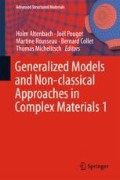Abstract
The goal of this paper is to link the geometric variables of strain gradient continuum with electromagnetic fields. For that purpose, we derive the electromagnetic wave equation within a Riemann-Cartan continuum where curvature and torsion are present. We also show that the gravitational and electromagnetic fields are respectively identified as geometric objects of such a continuum, namely the curvature \( \Re_{\alpha \beta \lambda }^{\gamma } \) for gravitation which is a classical result, and the torsion \( \aleph_{\alpha \beta }^{\gamma } \) as source of electromagnetism.
Access this chapter
Tax calculation will be finalised at checkout
Purchases are for personal use only
Preview
Unable to display preview. Download preview PDF.
References
Antonio Tamarasselvame N, Rakotomanana L (2011) On the form-invariance of Lagrangean function for higher gradient continuum. In: Altenbach H, Maugin GA, Erofeev V (eds) Mechanics of Generalized Continua, Heidelberg, ASM, vol 7, pp 291–322
Charap JM, Duff MJ (1977) Gravitational effects on Yang-Mills topology. Physics Letters 69B(4):445–447
Cho YM (1976) Einstein Lagrangian as the translational Yang-Mills Lagrangian. Physical Review D 14(10):2521–2525
de Andrade VC, Pereira JG (1999) Torsion and the electromagnetic field. International Journal of Modern Physics D 8(2):141–151
Dias L, Moraes F (2005) Effects of torsion on electromagnetic fields. Brazilian Journal of Physics 35(3A):636–640
Fernado J, Giglio T, Rodrigues Jr WA (2012) Gravitation and electromagnetism as geometrical objects of Riemann-Cartan spacetime structure. Advanced Applied Clifford Algebras 22:640–664
Fernandez-Nunez I, Bulashenko O (2016) Anisotropic metamaterial as an anlogue of a black hole. Physics Letters A 380:1–8
Fumeron S, Pereira E, Moraes F (2015) Generation of optical vorticity from topological defects. Physica B 476:19–23
Futhazar G, Le Marrec L, Rakotomanana LR (2014) Covariant gradient continua applied to wave propagation within defected material. Archive for Applied Mechanics 84(9–11):1339–1356
Hammond RT (1987) Gravitation, Torsion, and Electromagnetism. General Relativity and Gravitation 20(8):813–827
Hammond RT (1989) Einstein-Maxwell theory from torsion. Classical Quantum and Gravitation 6:195–198
Hehl FW (2008) Maxwell’s equations in Minkowski’s world: their premetric generalization and the electromagnetic energy-momentum tensor. Annalen der Physik 17(9-10):691–704
Hehl FW, von der Heyde P (1973) Spin and the structure of spacetime. Annales de l’Institut Henri Poincaré, section A 19(2):179–196
Hehl FW, von der Heyde P, Kerlick JM G D ans Nester (1976) General relativity with spin and torsion: Foundations and prospects. Reviews of Modern Physics 48(3):393–416
Kleinert H (2008) Multivalued Fields: in Condensed matter, Electromagnetism, and Gravitation. World Scientific, Singapore
Kovetz A (2000) Electromagnetic Theory. Oxford University Press, Oxford
Maugin G (1993) Material Inhomogeneities in Elasticity. Chapman and Hall, London
Maugin GA (1978) Exact relativistic theory of wave propagation in prestressed nonlinear elastic solids. Annales de l’Institut Henri Poincaré, section A 28(2):155–185
Milonni PW, Boyd RW (2010) Momentum of light in a dielectric medium. Adv Opt Photon 2(4):519–553
Obukhov YN (2008) Electromagnetic energy and momentum in moving media. Annalen der Physik 17(9-10):830–851
Obukhov YN, Hehl FW (2003) Electromagnetic energy-momentum and forces in matter. Physics Letters A 311:277–284
Plebanski J (1960) Electromagnetic waves in gravitational fields. Physical Review 118(5):1396–1408
Poplawski NJ (2010) Torsion as electromagnetism and spin. International Journal of Theoretical Physics 49(7):1481–1488
Prasanna AR (1975) Maxwell’s equations in Riemann-Cartan space U 4. Physics Letters A 54(1):17–18
Puntigam RA, Lämmerzahl C, Hehl FW (1997) Maxwell’s theory on a post-Riemannian spacetime and the equivalence principle. Classical and Quantum Gravitation 14:1347–1356
Rakotomanana RL (2003) A Geometric Approach to Thermomechanics of Dissipating Continua. Progress in Mathematical Physics Series, Birkhaüser, Boston
Schutzhold R, Plunien G, Soff G (2002) Dielectric black hole analogs. Physical Review Letters 88(6):061,101/1–061,101/4
Smalley LL (1986) On the extension of geometric optics from Riemaniann to Riemann-Cartan spacetime. Physics Letters A 117(6):267–269
Smalley LL, Krisch JP (1992) Minimal coupling of electromagnetic fields in Riemann-Cartan spacetimes for perfect fluids with spin density. Journal of Mathematical Physics 33(3):1073–1081
Sotiriou TP, Liberati S (2007) Metric-affine f (R) theories of gravity. Annals of Physics 322:935–966
Tiwari RN, Ray S (1997) Static spherical charged dust electromagnetic mass models in Einstein- Cartan theory. General Relativity and Gravitation 29(6):683–690
Vandyck MA (1996) Maxwell’s equations in spaces with non-metricity and torsion. J Physics A : Math Gen 29:2245–2255
Author information
Authors and Affiliations
Corresponding author
Editor information
Editors and Affiliations
Rights and permissions
Copyright information
© 2018 Springer International Publishing AG, part of Springer Nature
About this chapter
Cite this chapter
Rakotomanana, L.R. (2018). Second Gradient Continuum: Role of Electromagnetism Interacting with the Gravitation on the Presence of Torsion and Curvature. In: Altenbach, H., Pouget, J., Rousseau, M., Collet, B., Michelitsch, T. (eds) Generalized Models and Non-classical Approaches in Complex Materials 1. Advanced Structured Materials, vol 89. Springer, Cham. https://doi.org/10.1007/978-3-319-72440-9_36
Download citation
DOI: https://doi.org/10.1007/978-3-319-72440-9_36
Published:
Publisher Name: Springer, Cham
Print ISBN: 978-3-319-72439-3
Online ISBN: 978-3-319-72440-9
eBook Packages: EngineeringEngineering (R0)

